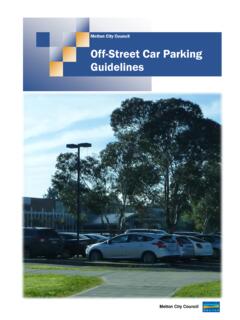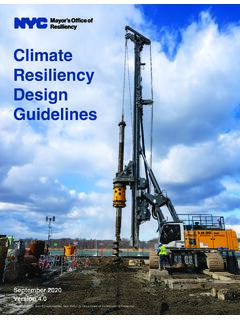Transcription of GUIDELINES FOR ON-SITE STORMWATER DETENTION
1 GUIDELINES FOR ON-SITE STORMWATER DETENTION Adopted: May 2009 Melton Shire Council GUIDELINES for ON-SITE STORMWATER DETENTION Report Prepared by: Engineering Services 2009 Page 1 Table of Contents INTRODUCTION 3 NEED FOR ON-SITE STORMWATER DETENTION 4 PRINCIPLES OF ON- SITE STORMWATER DETENTION 4 DESIGN & CONSTRUCTION PARAMETERS & DETAILS FOR OSD 5 DESIGN PARAMETERS 5 DESIGN DETAILS 5 ON-SITE Storage Volume (Vs) 5 Underground Storage Systems 6 Surface Storage Systems 6 Ponding Limits 6 Rainwater Tanks 7 FLOW CONTROL OUTLET 8 Orifice System 8 Multi Cell 10 ON SITE STORAGE DETENTION CALCULATION 11 Calculation using OSD4 package 12 PUMP-OUT SYSTEM 12 INFORMATION REQUIRED TO BE SUBMITTED 12 INITIAL SUBMISSION. 12 Information required on drainage drawings. 13 Information required on calculation sheets 13 FINAL SUBMISSION.
2 14 POST DEVELOPMENT DOCUMENTATION 14 GLOSSARY 14 REFERENCES 14 Melton Shire Council GUIDELINES for ON-SITE STORMWATER DETENTION Report Prepared by: Engineering Services 2009 Page 2 CONTACT INFORMATION 15 Melton Shire Council GUIDELINES for ON-SITE STORMWATER DETENTION Report Prepared by: Engineering Services 2009 Page 3 Introduction Redevelopment of a site usually increases the area covered by hard impervious surfaces such as roofing and paving. The change in the average permeability of the site significantly increases the volume and flow rate of storm water runoff and the additional drainage loads may cause local flash flooding downstream of the site. Due to the number of residential redevelopments and other redevelopments taking place within the Shire, it has become necessary to limit the peak rate of runoff reaching the Council s drainage system.
3 ON-SITE STORMWATER DETENTION (OSD) is a STORMWATER management technique that enables the runoff discharge rates of individual development sites to be controlled. An OSD system requires a flow control device to limit the discharge to an acceptable rate and a storage system to hold the excess discharge until capacity becomes available in the downstream drainage system. Large DETENTION basins are expensive even if built on public land and only provide protection against downstream flooding. Properties upstream of a DETENTION basin are not protected from the increased runoff caused by redevelopment. Well-designed OSD systems control the peak discharge rates to match the capacity of the downstream drainage system. The total volume of STORMWATER leaving the site is not reduced but the retained volume is released when downstream drainage capacity becomes available.
4 Requiring the installation of OSD systems on redevelopment sites ensures there are no adverse impacts from STORMWATER runoff on downstream properties as a result of ongoing development in the catchment. Melton Shire Council GUIDELINES for ON-SITE STORMWATER DETENTION Report Prepared by: Engineering Services 2009 Page 4 Need for ON-SITE STORMWATER DETENTION The design and construction of an OSD system to control runoff from a site will be required for developments in the Shire of Melton that result in increased impervious areas above the original designed values. A requirement of an OSD system is expected as a condition on the planning permit. And the number of dwellings/buildings is immaterial. Principles of On- site STORMWATER DETENTION ON-SITE STORMWATER DETENTION systems are used as part of the STORMWATER drainage system to reduce the impacts of site development on receiving drains and waterways.
5 At the onset of a storm, STORMWATER will commence to discharge from the site. The earliest flow will be from areas nearest the discharge point but will increase significantly as water from the furthest points of the property reaches the discharge point. As the intensity of the storm approaches its peak, the discharge rate will increase relatively sharply to a maximum. The discharge rate will subside after the peak has passed. If the highest discharge rate for the catchment s critical storm event will exceed the permissible site discharge (PSD) rate, as indicated by the Responsible Authority, an ON-SITE STORMWATER DETENTION (OSD) system will have to be installed. The system will temporarily store any excess flow and release it at a controlled lower rate over a longer period of time. A DETENTION system has two components a device to control the flow rate of the discharge from the site and storage for the excess STORMWATER .
6 The storage can be provided via underground or aboveground pipes or tanks. Ground level storage is provided by allowing water to pond in a broad but shallow depression in a paved area such as a driveway. Melton Shire Council GUIDELINES for ON-SITE STORMWATER DETENTION Report Prepared by: Engineering Services 2009 Page 5 Design & Construction Parameters & Details for OSD OSD designs shall be prepared by a suitably qualified and registered engineering consultant, in accordance with the Council s requirement. Design Parameters Key aspects of the OSD procedure are to determine the Permissible Site Discharge (PSD) and Storage Volume (Vs) for the storage configuration that is adopted by the designer. The following are the main criteria required to determine the PSD and Vs. Site area. Weighted coefficient of runoff at the initial subdivision stage information shall be obtained from Council.
7 Weighted coefficient of runoff at the post development stage. Time of concentration for the entire catchment, which relevant site has been located information shall be obtained from Council. Travel time from the site discharge point to the catchment outlet information shall be obtained from Council. Average Recurrence Intervals: For the permissible site discharge, o Residential area 5 year ARI o Industrial area 10 year ARI Site Storage Requirement: o Residential area 10 year ARI o Industrial area 20 year ARI Design Details ON-SITE Storage Volume (Vs) The minimum volume of the ON-SITE storage depends upon the following. Permissible Site Discharge Adopted storage system and/or configuration And a number of the parameters listed in above. NOTE: If storm events of the same ARI, but having durations more than the catchment specific critical duration, cause the storage to overflow, it will be necessary to increase the storage volume.
8 The designer will be required to maximise the storage volume to ensure that the system does not fail for a storm event of any duration. Melton Shire Council GUIDELINES for ON-SITE STORMWATER DETENTION Report Prepared by: Engineering Services 2009 Page 6 Underground Storage Systems Underground storage systems are suitable for use as OSD storages. These systems should be located in areas where they can be readily accessed for inspections and maintenance. These systems must be watertight. Otherwise, if there is the potential for water seepage, this may cause damage to adjacent properties or structures. Where possible, a visible overflow should be built into the system. Surface Storage Systems Surface storage can be provided either in landscaped and/or driveways and car park areas. Ponding Limits In the interests of safety and amenity, storage water depths for DETENTION systems should not exceed the following: Feature Maximum Depth Parking / Paved Area 100mm desirable 150mm maximum Front Setback Landscaped / Common areas 300mm desirable 600mm maximum Covered / Fenced Storage Consult with Council for Limits Roof Area According to the Structural Integrity Table 1 The following shall also be considered.
9 The finish levels of external porch/verandah areas shall be set a minimum of 100mm above the top of water level of the basin. The ponding shall begin to occur as far as possible from all external porch/verandah areas. As a minimum, a dry access/escape route shall be provided for individual residences. An additional 20% storage volume shall be provided in courtyard areas to allow for future unintentional reduction in storage. Melton Shire Council GUIDELINES for ON-SITE STORMWATER DETENTION Report Prepared by: Engineering Services 2009 Page 7 Rainwater Tanks Rainwater tanks may be acceptable for providing some of the OSD storage volume. If the developer/consultant proposes to use rainwater tanks, the rainwater tank shall be modified to comply with Figure 1 and other comments listed below. Council accepts the following types of design: Rainwater tank for each unit/dwelling/building that collects water from the roof of both unit/dwelling/building and garage.
10 The maximum temporary storage (airspace) of tanks shall not be exceeded one third of the total site storage amount. However, the temporary storage volume provided in the rainwater tanks cannot exceed one third of the rainwater tank or on third of the total storage requirement whichever is lesser. The roof area/impervious area connected to the rainwater tank shall be proportionately equal to the percentage of temporary storage within the rainwater tank. Controlled outflow from the airspace of each rainwater tank shall be a maximum 1 l/s. This would require a 25-30 mm diameter outlet from the rainwater tank if the outlet is located approximately 600mm below the top of the rainwater tank. To avoid having a closed system (ie. To get rid of the effect of additional water head), the 100mm diameter outlet pipe connected to the tank shall have a 25-30mm diameter orifice to restrict flow.




